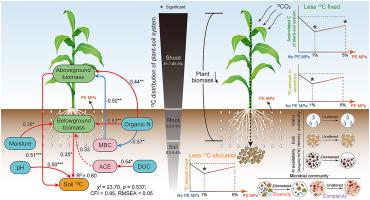Journal of Cleaner Production ( IF 9.7 ) Pub Date : 2022-12-08 , DOI: 10.1016/j.jclepro.2022.135558 Ziqiang Liu , Zhijun Su , Jiayi Chen , Jiayu Zou , Zhenxiu Liu , Yazheng Li , Jing Wang , Lizhu Wu , Hui Wei , Jiaen Zhang

|
Microplastics (MPs) are emerging environmental pollutants that potentially affect soil carbon (C) cycling. However, how MPs influence photosynthesized C flow from plants to soil remains unclear, creating large uncertainties in the projection of C dynamics in plant-soil-atmosphere systems. Herein, a 13C-labeling technique was applied to unravel the photosynthesized C fluxes from maize to soil under different levels of simulated polyethylene (PE) MPs pollution (0, 1% and 5%) in soil. Resultantly, the 1% and 5% PE MPs treatments significantly decreased the net fixed 13C in the maize–soil system. However, the effect of PE MPs on photosynthate–13C transfer in the maize–soil system was highly concentration–specific, that is, the addition of 1% PE MPs reduced the transfer of photosynthate–13C to the belowground part (−44.6%) and soil (−36.3%), whereas these effects were not observed for 5% PE MPs. PE MPs addition did not change soil moisture and bulk density. The addition of 1% PE MPs increased soil microbial biomass and decreased soil nitrogen (N) availability (inorganic and organic N). The treatment with 5% PE MPs decreased soil microbial community diversity, and altered the microbial community structure. Soil pH, organic N, and aboveground and belowground plant biomass mainly controlled the soil 13C content. These findings suggest that plant–soil systems polluted by PE MPs would sequester less photosynthesized C to belowground parts and soil through reducing plant photosynthetic carbon assimilation and transfer. Thus, potential changes in soil C stocks under MPs pollution should be considered for predicting global C dynamics and sustainable agricultural production.
中文翻译:

聚乙烯微塑料可以通过减少植物光合碳同化和转移来减弱土壤碳固存:来自 13C 标记的中观研究的证据
微塑料 (MP) 是新兴的环境污染物,可能会影响土壤碳 (C) 循环。然而,MPs 如何影响从植物到土壤的光合作用 C 流量仍不清楚,这在植物-土壤-大气系统中的 C 动态预测中产生了很大的不确定性。在此,应用13 C 标记技术来揭示在土壤中不同水平的模拟聚乙烯 (PE) MPs 污染(0%、1% 和 5%)下从玉米到土壤的光合作用 C 通量。结果,1% 和 5% PE MPs 处理显着降低了玉米-土壤系统中的净固定13 C。然而,PE MPs 对光合产物的影响 – 13玉米-土壤系统中的 C 转移具有高度浓度特异性,即添加 1% PE MPs 减少了光合产物 - 13 C 向地下部分 (-44.6%) 和土壤 (-36.3%) 的转移,而对于 5% PE MP,未观察到这些影响。添加 PE MPs 不会改变土壤水分和容重。添加 1% PE MP 可增加土壤微生物生物量并降低土壤氮 (N) 可用性(无机和有机 N)。5% PE MPs 处理降低了土壤微生物群落多样性,改变了微生物群落结构。土壤pH值、有机氮、地上和地下植物生物量主要控制土壤13C内容。这些发现表明,被 PE MP 污染的植物-土壤系统会通过减少植物光合作用的碳同化和转移,将较少的光合作用 C 螯合到地下部分和土壤。因此,在预测全球碳动态和可持续农业生产时,应考虑 MPs 污染下土壤碳库的潜在变化。





















































 京公网安备 11010802027423号
京公网安备 11010802027423号